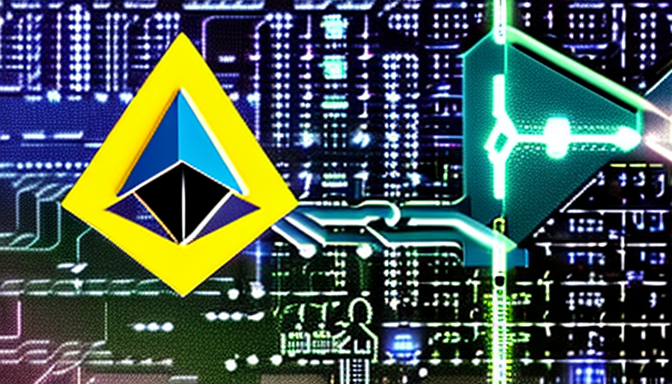Ethereum has established itself as a cornerstone technology for decentralized finance (DeFi), offering a myriad of financial services that operate independently of traditional intermediaries. This evolution in financial services is not just a trend but a significant shift towards a more inclusive financial system. By utilizing Ethereum’s blockchain technology, users can engage in activities such as lending, borrowing, and trading, all while maintaining control over their assets.
Understanding Ethereum and Smart Contracts
At the heart of Ethereum’s functionality are smart contracts. These self-executing contracts have their terms written directly into code, allowing for automated transactions without the need for a trusted third party. For instance, a smart contract can facilitate a loan agreement where funds are automatically released once certain conditions are met, thereby reducing the risk of default. This innovative approach not only streamlines processes but also enhances transparency and security in financial transactions.
The Growth of Decentralized Finance (DeFi)
The DeFi sector has witnessed phenomenal growth, with Ethereum serving as its backbone. According to recent studies, over 75% of DeFi applications are built on the Ethereum network. This platform enables users to access financial services that were previously restricted to those with significant capital or connections within traditional financial institutions. For example, decentralized exchanges (DEXs) allow users to trade cryptocurrencies directly from their wallets, eliminating the need for centralized exchanges and enhancing user privacy.
- Decentralized Exchanges (DEXs): Platforms like Uniswap and SushiSwap exemplify how Ethereum facilitates peer-to-peer trading, offering users greater control and security.
- Lending Platforms: Services such as Aave and Compound allow users to lend and borrow assets with flexible interest rates, ensuring efficient capital utilization.
- Yield Farming: Users can earn rewards by providing liquidity to DeFi protocols, creating new income streams while contributing to the platform’s growth.
Challenges Facing Ethereum in DeFi
Despite its advantages, Ethereum faces several challenges, including scalability and high transaction fees. As the network becomes increasingly congested, users may experience delays and elevated costs, which can deter participation in DeFi activities. To address these issues, Ethereum 2.0 is being developed, transitioning to a proof-of-stake consensus mechanism that promises to enhance transaction speeds and reduce costs significantly.
Future Trends in Ethereum and DeFi
As the DeFi landscape evolves, several trends are emerging. Regulatory scrutiny is increasing, compelling platforms to consider compliance measures that ensure consumer protection without stifling innovation. Additionally, the integration of artificial intelligence into DeFi platforms is poised to revolutionize user experiences by offering personalized financial advice, risk assessments, and automated trading strategies.
In conclusion, Ethereum’s role in DeFi is not just transformative but essential for the future of finance. By continuing to innovate and address existing challenges, Ethereum can further democratize access to financial services, paving the way for a more equitable financial system.

Understanding Ethereum and Smart Contracts
Ethereum is a revolutionary blockchain platform that has transformed the way developers create decentralized applications (dApps). At its core, Ethereum enables the execution of smart contracts—self-executing contracts where the terms are directly encoded into the software. This innovation not only automates processes but also ensures transparency and security, as the code is immutable and publicly accessible on the blockchain.
Smart contracts function as digital agreements that automatically execute actions when pre-defined conditions are met. For instance, in a lending scenario, a smart contract can facilitate a loan by automatically transferring funds to the borrower once the collateral is verified. This eliminates the need for intermediaries, reducing costs and enhancing efficiency.
One of the most significant applications of Ethereum’s smart contracts is in the realm of decentralized finance (DeFi). DeFi platforms leverage these contracts to provide financial services such as lending, borrowing, and trading without traditional banking systems. According to a report by DeFi Pulse, the total value locked in DeFi protocols has surged to over $100 billion in recent years, highlighting the growing trust in Ethereum’s capabilities.
Moreover, Ethereum’s architecture supports a wide array of dApps, ranging from decentralized exchanges (DEXs) like Uniswap to lending platforms such as Aave. Each of these applications utilizes smart contracts to operate seamlessly, allowing users to engage in financial transactions with minimal risk of fraud. For example, Uniswap employs an automated market-making system that ensures liquidity without requiring a centralized exchange.
However, the growth of Ethereum and its smart contracts is not without challenges. Issues such as scalability and high transaction fees have raised concerns among users. Research from the Ethereum Foundation indicates that as the network becomes congested, gas fees can spike, making transactions costly and less accessible to everyday users. This has led to the exploration of Layer 2 solutions, which aim to enhance transaction throughput while maintaining security.
In conclusion, Ethereum’s innovative use of smart contracts is reshaping the financial landscape by providing decentralized alternatives to traditional finance. As the ecosystem continues to evolve, ongoing research and development will be crucial in addressing the challenges faced by Ethereum, ensuring it remains a cornerstone of the DeFi revolution.
- Key Features of Smart Contracts:
- Self-executing agreements
- Transparency and immutability
- Reduced costs by eliminating intermediaries
- Challenges:
- Scalability issues
- High transaction fees

The Growth of Decentralized Finance (DeFi)
has marked a significant shift in the financial landscape, with Ethereum serving as the backbone of this transformative movement. By leveraging blockchain technology, DeFi enables users to engage in financial activities such as lending, borrowing, and trading without the need for traditional financial intermediaries like banks. This democratization of financial services has opened up opportunities for millions worldwide, particularly in regions with limited access to conventional banking systems.
Ethereum’s smart contracts are pivotal to the functionality of DeFi applications. These self-executing contracts automate transactions and enforce agreements without human intervention, reducing the risk of fraud and increasing efficiency. For instance, platforms like Aave and Compound utilize smart contracts to facilitate peer-to-peer lending, allowing users to earn interest on their deposits while providing borrowers access to funds without lengthy approval processes.
Furthermore, the rise of decentralized exchanges (DEXs) such as Uniswap and SushiSwap has revolutionized the trading of cryptocurrencies. These platforms allow users to trade directly from their wallets, eliminating the need for a centralized authority. This not only enhances user privacy but also minimizes the risks associated with centralized exchanges, such as hacking and insolvency issues.
- Lending Platforms: Aave and Compound exemplify how users can lend and borrow assets, often using collateral to secure loans. This mechanism reduces the risk for lenders and facilitates a more stable borrowing environment.
- Yield Farming: Users can maximize their returns by participating in yield farming, which involves providing liquidity to DeFi protocols in exchange for rewards, often in the form of additional tokens.
Despite its rapid growth, DeFi faces challenges, particularly regarding scalability and transaction costs. High demand on the Ethereum network has led to increased gas fees, which can deter smaller investors from participating. To address this, Ethereum is transitioning to a proof-of-stake model with Ethereum 2.0, which promises to enhance transaction speeds and reduce costs significantly.
Moreover, the integration of Layer 2 scaling solutions, such as Optimistic Rollups and zk-Rollups, aims to alleviate congestion on the Ethereum network. These technologies enable off-chain transactions, thereby improving throughput and user experience.
As DeFi continues to evolve, its future will likely be shaped by increased regulatory scrutiny, the emergence of innovative financial products, and the integration of artificial intelligence. Regulatory frameworks will need to balance consumer protection with the promotion of innovation. Meanwhile, AI can enhance user experiences through personalized financial services and automated trading strategies, paving the way for a more accessible and efficient DeFi ecosystem.
In conclusion, the growth of DeFi represents a paradigm shift in finance, driven by Ethereum’s robust technology. As the ecosystem matures, it holds the potential to reshape how individuals and businesses access financial services globally.
Key DeFi Applications on Ethereum
have revolutionized the financial landscape by providing users with innovative tools and services that operate without traditional financial institutions. These applications utilize Ethereum’s robust smart contract functionality to create decentralized ecosystems where users maintain control over their assets. This section explores several prominent DeFi applications, highlighting their unique features and the opportunities they present.
One of the most significant categories of DeFi applications is Decentralized Exchanges (DEXs). Platforms like Uniswap and SushiSwap enable users to trade cryptocurrencies directly from their wallets, eliminating the need for a central authority. This decentralization enhances user privacy and security while promoting liquidity through automated market-making algorithms. Research indicates that DEXs have seen a dramatic increase in trading volume, reflecting a shift in user preference towards decentralized trading solutions. For instance, Uniswap’s trading volume reached over $1 billion in a single day during peak activity periods, showcasing the platform’s growing popularity.
Another vital aspect of DeFi is Lending Platforms, such as Aave and Compound. These platforms allow users to lend and borrow digital assets, often at competitive interest rates. Users can earn interest on their idle assets by providing liquidity to the platform, while borrowers can access funds without the stringent requirements of traditional banks. A study published in the Journal of Financial Technology highlights that the average annual percentage yield (APY) on lending platforms can surpass traditional savings accounts by several magnitudes, making them attractive alternatives for yield-seeking investors.
Yield Farming is another innovative feature of DeFi applications. This process involves users staking or lending their assets in exchange for rewards, typically in the form of additional tokens. Yield farming protocols, such as Yearn.finance, optimize the allocation of users’ funds across various lending platforms to maximize returns. According to a report by DeFi Pulse, yield farming has attracted billions in capital, illustrating the growing interest in earning passive income through decentralized finance.
Despite these advancements, users must remain aware of the risks associated with DeFi applications. Issues such as smart contract vulnerabilities, market volatility, and regulatory uncertainties can impact user experience and financial outcomes. A comprehensive understanding of these risks is essential for users looking to navigate the DeFi landscape effectively.
In conclusion, the key DeFi applications on Ethereum, including DEXs, lending platforms, and yield farming protocols, offer unique functionalities that empower users in the financial ecosystem. As these applications continue to evolve, they present exciting opportunities for innovation and growth in the decentralized finance sector.
Decentralized Exchanges (DEXs)
Decentralized exchanges (DEXs) have revolutionized the way users engage with cryptocurrency trading, providing a platform that emphasizes user autonomy and privacy. Unlike traditional exchanges, which require users to deposit their funds into a centralized account, DEXs like Uniswap and SushiSwap facilitate trades directly from users’ wallets. This model not only enhances user control over their assets but also significantly reduces the risks associated with centralized platforms, such as hacking and mismanagement of funds.
One of the primary advantages of DEXs is their decentralized nature, which eliminates the need for an intermediary. This allows users to trade cryptocurrencies without the constraints often associated with centralized exchanges, such as identity verification and withdrawal limits. Users can maintain their privacy and security, as their personal information is not required to execute trades. This is particularly appealing in an era where data breaches and privacy concerns are prevalent.
Moreover, DEXs operate on smart contracts, which are self-executing contracts with the agreement directly written into code. This technology ensures that trades are executed automatically and transparently, minimizing the chances of fraud. For instance, when a user initiates a trade on Uniswap, the smart contract automatically matches the buyer and seller, facilitating the exchange without human intervention. This not only speeds up the trading process but also ensures that the terms of the transaction are adhered to without the possibility of manipulation.
Furthermore, DEXs often offer a broader range of trading pairs compared to their centralized counterparts. Users can access a variety of tokens, including newly launched cryptocurrencies that may not yet be listed on larger exchanges. This democratization of access allows for greater participation in the cryptocurrency market, enabling users to discover and invest in emerging projects that align with their interests.
Despite these advantages, DEXs are not without challenges. Users must be cautious about the potential for smart contract vulnerabilities, which can be exploited by malicious actors. Additionally, the user experience can be less intuitive compared to centralized exchanges, particularly for those new to cryptocurrency trading. However, ongoing innovations in user interface design and educational resources are helping to bridge this gap.
In conclusion, decentralized exchanges represent a significant advancement in the cryptocurrency landscape, empowering users by allowing them to trade directly from their wallets while maintaining privacy and security. As the DeFi ecosystem continues to evolve, DEXs are likely to play an increasingly important role, offering users greater control and access to a diverse range of financial opportunities.
Lending Platforms
in the decentralized finance (DeFi) ecosystem have transformed the way individuals and institutions engage in financial transactions. By utilizing blockchain technology, these platforms—such as Aave and Compound—allow users to lend and borrow cryptocurrencies efficiently, with the added flexibility of variable interest rates. This innovation not only enhances liquidity in the market but also democratizes access to financial services, making them available to a broader audience.
At the core of these lending platforms is the use of collateral. Users who wish to borrow assets must provide collateral, which is often a cryptocurrency of higher value than the amount being borrowed. This mechanism minimizes risk for lenders, as the collateral can be liquidated if the borrower fails to repay the loan. For example, if a user borrows $1,000 worth of Ethereum, they might need to lock up $1,500 worth of another asset as collateral. This practice ensures that lenders are protected against default.
The interest rates on these platforms are typically variable, influenced by supply and demand dynamics. When more users want to borrow assets, interest rates rise, incentivizing lenders to provide more liquidity. Conversely, when borrowing decreases, interest rates tend to fall. This system creates a self-regulating environment that adjusts to market conditions in real-time, providing a more responsive and efficient financial ecosystem.
Research by the Cambridge Centre for Alternative Finance indicates that DeFi lending platforms have seen a significant increase in total value locked (TVL), reflecting growing user trust and adoption. As of 2023, platforms like Aave and Compound have collectively facilitated billions in loans, showcasing their pivotal role in the financial landscape.
- Aave: Known for its unique features like flash loans and rate switching, Aave allows users to borrow and lend a wide range of cryptocurrencies.
- Compound: This platform operates on a supply and borrow model, where users can earn interest on their assets while also borrowing against them.
While lending platforms offer numerous benefits, they are not without challenges. Issues such as smart contract vulnerabilities, market volatility, and regulatory scrutiny pose risks that users must navigate. Therefore, it is crucial for participants in the DeFi space to conduct thorough research and understand the mechanisms at play.
In conclusion, lending platforms like Aave and Compound signify a shift towards a more decentralized financial system. By leveraging technology to facilitate lending and borrowing, these platforms provide opportunities for users to engage in financial activities that were previously restricted by traditional banking systems. As DeFi continues to evolve, the importance of understanding these platforms will only grow, paving the way for a more inclusive financial future.
Challenges Facing Ethereum in DeFi
Ethereum has undeniably transformed the landscape of decentralized finance (DeFi) by providing a robust platform for a variety of financial applications. However, it is essential to address the significant challenges that accompany this innovation. Among the most pressing issues are scalability and high transaction fees, both of which can substantially affect the user experience and accessibility of DeFi services.
The scalability problem arises from Ethereum’s current capacity to handle a limited number of transactions per second (TPS). As more users engage with DeFi applications, the network often becomes congested. According to a report by Ledger Insights, Ethereum can process around 30 TPS, which pales in comparison to traditional financial systems that can handle thousands of transactions simultaneously. This limitation leads to slower transaction times, frustrating users who expect seamless interactions.
Moreover, high transaction fees, commonly referred to as gas fees, pose another barrier. During peak usage times, these fees can skyrocket, making it prohibitively expensive for users to conduct even minor transactions. A study published in the Journal of Financial Stability indicated that gas fees can fluctuate significantly, with some users reporting costs exceeding $100 for a single transaction. This volatility can deter new users from entering the DeFi space and can alienate existing users who may feel that the costs outweigh the benefits.
To illustrate, consider a user wishing to swap tokens on a decentralized exchange (DEX). If the gas fees are excessively high, the user may opt to delay the transaction or abandon it altogether, ultimately reducing overall trading volume on the platform. This scenario highlights the need for solutions that can enhance Ethereum’s capacity to handle increased demand without imposing high costs on users.
In response to these challenges, various scalability solutions are being explored. Layer 2 protocols, such as Optimistic Rollups and zk-Rollups, aim to alleviate congestion by processing transactions off the main Ethereum chain while still ensuring security and decentralization. Additionally, the anticipated transition to Ethereum 2.0, which incorporates a proof-of-stake consensus mechanism, promises to improve transaction speeds and reduce fees significantly.
In conclusion, while Ethereum has laid the groundwork for a revolutionary DeFi ecosystem, addressing scalability and transaction fees is crucial for its continued success. As developers and researchers work on innovative solutions, the hope is that these challenges can be mitigated, allowing for a more inclusive and efficient financial landscape.

Ethereum 2.0 and Its Impact on DeFi
Ethereum 2.0 represents a significant evolution of the Ethereum network, particularly in the context of decentralized finance (DeFi). It introduces a proof-of-stake (PoS) consensus mechanism, which is designed to address several critical challenges that have historically plagued the Ethereum blockchain, notably scalability and high transaction costs. This transition is not merely a technical upgrade; it holds the potential to revolutionize how financial services are delivered in a decentralized ecosystem.
One of the most pressing issues within the current Ethereum network is its scalability. As DeFi applications have surged in popularity, the demand for transaction processing has increased exponentially. This has often resulted in network congestion, leading to significant delays and soaring gas fees. With Ethereum 2.0, the implementation of PoS is expected to enhance transaction speeds dramatically. Research indicates that PoS could allow Ethereum to process thousands of transactions per second compared to the current rate of approximately 30 transactions per second, thus improving user experience and accessibility.
In addition to scalability, the cost of transactions has been a barrier for many users. High gas fees can deter small investors and limit participation in DeFi activities. Ethereum 2.0 aims to reduce these costs by optimizing how transactions are validated and processed. Studies have shown that lower transaction costs can significantly increase user engagement and participation in DeFi platforms, fostering a more inclusive financial system.
The transition to Ethereum 2.0 is also expected to enhance security within the network. PoS reduces the risk of 51% attacks that are more feasible in proof-of-work systems, as the economic incentives are aligned differently. In PoS, validators are required to hold and stake their Ether, which means that malicious activities could lead to a loss of their staked assets. This economic model encourages honest behavior and strengthens the overall integrity of the network.
Moreover, the integration of Layer 2 solutions alongside Ethereum 2.0 will further augment its capabilities. Technologies such as Optimistic Rollups and zk-Rollups are designed to process transactions off-chain while ensuring that the security of the Ethereum main chain is maintained. This hybrid approach can lead to faster and cheaper transactions, making DeFi applications more viable and attractive to a broader audience.
In conclusion, Ethereum 2.0 is poised to play a pivotal role in the future of decentralized finance. By addressing scalability, reducing transaction costs, and enhancing security, it opens up new possibilities for innovation within the DeFi space. As the transition progresses, it will be crucial for developers and users alike to understand these changes and adapt to the evolving landscape of decentralized finance.
Scalability Solutions
are critical in addressing the challenges faced by the Ethereum blockchain, particularly in the context of the decentralized finance (DeFi) ecosystem. As the number of users and transactions has surged, the need for enhanced transaction throughput has become increasingly apparent. Layer 2 solutions, such as Optimistic Rollups and zk-Rollups, have emerged as promising technologies designed to alleviate these scalability issues.
Optimistic Rollups operate on the principle of assuming that transactions are valid by default, which allows for the aggregation of multiple transactions into a single batch before they are confirmed on the Ethereum main chain. This method significantly reduces the load on the main chain and enhances transaction speeds. Research indicates that Optimistic Rollups can increase transaction throughput by a factor of up to 100, making them a compelling option for DeFi applications that require rapid processing times.
On the other hand, zk-Rollups utilize zero-knowledge proofs to ensure that transactions are valid without revealing any sensitive information. This technology not only enhances privacy but also allows for the confirmation of a large number of transactions in a single proof. A study published in the Journal of Cryptographic Engineering demonstrated that zk-Rollups could achieve a throughput of up to 2000 transactions per second, showcasing their potential to support high-demand DeFi applications.
- Benefits of Layer 2 Solutions:
- Increased Throughput: Layer 2 solutions can handle significantly more transactions than the Ethereum main chain.
- Lower Fees: By reducing congestion on the main chain, these solutions can decrease transaction costs for users.
- Enhanced User Experience: Faster transaction times lead to a more seamless experience for users interacting with DeFi platforms.
Moreover, the integration of these scalability solutions is vital for the sustainability of Ethereum’s DeFi ecosystem. As more applications are developed, the demand for efficient transaction processing will only increase. According to a report from the Ethereum Foundation, implementing Layer 2 solutions could potentially support the projected growth of DeFi, which is expected to reach a market cap of over $1 trillion in the next few years.
In conclusion, the development of Layer 2 scaling solutions like Optimistic Rollups and zk-Rollups is pivotal in enhancing Ethereum’s capacity to support a thriving DeFi ecosystem. By addressing scalability challenges, these technologies not only improve transaction throughput but also contribute to the overall accessibility and usability of decentralized finance. As the ecosystem continues to evolve, ongoing research and innovation in this area will be essential to meet the demands of users and developers alike.
Interoperability with Other Blockchains
has become an essential aspect of the blockchain ecosystem, particularly in the realm of decentralized finance (DeFi). As the demand for cross-chain functionality grows, protocols like Polkadot and Cosmos have emerged as key players, enabling Ethereum to connect seamlessly with other blockchain networks. This connectivity enhances the overall functionality and reach of DeFi applications, allowing for a more integrated financial landscape.
The significance of interoperability cannot be overstated. By facilitating communication between disparate blockchains, these protocols allow Ethereum-based DeFi applications to leverage the unique features and capabilities of other networks. For instance, Polkadot employs a multi-chain architecture that enables different blockchains to share information and assets securely. This means that a DeFi application on Ethereum can access liquidity from a different blockchain, thereby increasing its operational efficiency and user base.
Similarly, Cosmos utilizes a hub-and-spoke model where various independent blockchains can connect to a central hub, enabling them to communicate and transact with each other. This design not only enhances scalability but also promotes innovation, as developers can create applications that operate across multiple chains. The ability to interact with other blockchains opens up new avenues for DeFi applications, such as cross-chain lending and borrowing, which can significantly improve user experience and financial inclusivity.
Research indicates that interoperability can lead to increased liquidity across different platforms. A study published in the Journal of Financial Technology highlights that cross-chain trading can reduce price volatility and enhance market stability. Furthermore, it allows users to take advantage of arbitrage opportunities, where they can buy assets at a lower price on one chain and sell them at a higher price on another.
However, there are challenges associated with interoperability. Security risks are a major concern, as connecting multiple blockchains can create vulnerabilities that malicious actors may exploit. Additionally, the complexity of integrating different protocols can lead to operational inefficiencies. Developers must prioritize robust security measures and comprehensive testing to mitigate these risks.
In conclusion, the interoperability of Ethereum with other blockchains through protocols like Polkadot and Cosmos is revolutionizing the DeFi landscape. By enhancing connectivity and enabling cross-chain functionality, these protocols are paving the way for a more integrated and efficient financial ecosystem. As the technology continues to evolve, we can expect to see even greater innovations that will further democratize access to financial services and improve user experiences in the DeFi space.

Future Trends in Ethereum and DeFi
As the decentralized finance (DeFi) landscape continues to expand, the role of Ethereum remains pivotal. The evolution of DeFi is significantly influenced by several emerging trends, including increased regulation, the development of innovative financial products, and the integration of artificial intelligence (AI). Each of these trends is expected to shape the future of Ethereum-based finance in profound ways.
One of the most pressing trends is the increased regulatory scrutiny surrounding DeFi platforms. Governments and regulatory bodies worldwide are beginning to recognize the potential risks associated with decentralized finance, such as fraud, money laundering, and consumer protection issues. For instance, the European Union is working on the Markets in Crypto-Assets (MiCA) regulation, which aims to establish a comprehensive framework for crypto assets, including DeFi. This regulatory environment may encourage more institutional investment in DeFi, as firms will seek compliance to mitigate legal risks.
In parallel, the emergence of new financial products is revolutionizing how users interact with DeFi platforms. Innovations such as synthetic assets, which mimic the value of real-world assets, and decentralized insurance protocols are gaining traction. For example, platforms like Synthetix allow users to trade synthetic assets that represent stocks, commodities, or fiat currencies, thus broadening the scope of investment opportunities available in the DeFi space. These products not only enhance liquidity but also provide users with sophisticated tools for risk management.
Moreover, the integration of artificial intelligence into DeFi applications is poised to transform user experiences. AI can analyze vast amounts of data to provide personalized financial advice, optimize trading strategies, and enhance risk assessment processes. For instance, AI-driven platforms can offer tailored lending solutions based on individual credit profiles, thus improving access to finance for a broader audience. Additionally, automated trading bots powered by AI can execute trades at optimal times, maximizing returns for investors.
In conclusion, the future of Ethereum and DeFi is shaped by the interplay of regulation, innovation in financial products, and technological advancements like AI. As these trends continue to evolve, they will not only enhance the functionality of DeFi platforms but also ensure that they operate within a framework that promotes safety and trust. Stakeholders in the DeFi ecosystem must stay informed and adapt to these changes to fully leverage the potential of Ethereum-based finance.
- Regulatory Scrutiny: Increased regulations may lead to greater institutional investment.
- Innovative Financial Products: Synthetic assets and decentralized insurance are expanding investment opportunities.
- AI Integration: Personalized financial services and optimized trading strategies are enhancing user experiences.
Regulatory Considerations
As the decentralized finance (DeFi) ecosystem continues to expand, the conversation surrounding has become increasingly pertinent. This heightened scrutiny arises from the need to ensure that innovative financial solutions do not compromise consumer protection or financial stability. The rapid evolution of DeFi, which leverages Ethereum’s capabilities, has prompted regulators worldwide to reevaluate existing frameworks.
One of the primary concerns is the lack of oversight in DeFi protocols, which can lead to potential risks for consumers. Unlike traditional finance, where regulatory bodies monitor transactions and enforce compliance, DeFi operates in a largely unregulated environment. This absence of oversight can expose users to risks such as fraud, hacking, and market manipulation. For instance, a study published in the Journal of Financial Stability highlighted several instances where users lost substantial funds due to vulnerabilities in smart contracts.
Moreover, the decentralized nature of these platforms complicates the enforcement of regulations. Many DeFi projects operate without a central authority, making it challenging for regulators to identify responsible parties. This has led to discussions about the necessity of self-regulatory organizations within the DeFi space, which could help establish best practices and standards that promote safety and transparency.
In response to these challenges, various countries are exploring regulatory frameworks that aim to strike a balance between fostering innovation and protecting consumers. For instance, the European Union’s Markets in Crypto-Assets (MiCA) regulation seeks to provide a comprehensive regulatory framework for crypto-assets, including DeFi. This legislation aims to create a safer environment for users while allowing innovation to thrive.
Furthermore, the integration of compliance measures within DeFi protocols is gaining traction. Projects that incorporate Know Your Customer (KYC) and Anti-Money Laundering (AML) procedures are emerging as potential solutions to address regulatory concerns. These measures can help build trust among users and regulators alike, ensuring that DeFi platforms operate within legal boundaries.
In conclusion, as DeFi continues to grow, the intersection of innovation and regulation will be crucial in shaping its future. The ongoing discussions surrounding compliance and consumer protection highlight the need for a balanced approach that encourages technological advancements while safeguarding users. The evolution of regulatory frameworks will be vital in ensuring that DeFi can operate sustainably and responsibly in the financial landscape.
Integration of Artificial Intelligence
The integration of artificial intelligence (AI) into decentralized finance (DeFi) platforms is a groundbreaking development that promises to revolutionize user engagement and financial services. By leveraging AI, DeFi platforms can offer personalized financial solutions tailored to individual user needs, thereby enhancing the overall experience.
One of the most significant advantages of AI in DeFi is its ability to perform advanced risk assessments. Traditional financial systems often rely on historical data and static models to evaluate risk, which can lead to inefficiencies and inaccuracies. In contrast, AI systems can analyze vast datasets in real time, identifying patterns and trends that may not be immediately apparent. For instance, machine learning algorithms can assess a user’s transaction history, market behavior, and even social media sentiment to provide a more nuanced risk profile. This enables platforms to offer dynamic interest rates and loan terms that reflect the true risk associated with each user.
Moreover, AI can significantly enhance automated trading strategies. By utilizing algorithms that learn from market fluctuations, AI systems can execute trades at optimal times, maximizing profits while minimizing losses. A study published in the Journal of Financial Markets demonstrated that AI-driven trading bots outperformed traditional trading strategies by an average of 15% over a six-month period. This capability is especially crucial in the volatile cryptocurrency market, where timely decision-making can make a substantial difference in financial outcomes.
In addition to trading and risk assessment, AI can also facilitate customer support through intelligent chatbots and virtual assistants. These AI-driven tools can provide users with instant responses to queries, guide them through complex processes, and even assist in troubleshooting issues. This not only improves user satisfaction but also reduces operational costs for DeFi platforms.
However, the integration of AI in DeFi is not without challenges. Concerns regarding data privacy and algorithmic bias must be addressed to ensure fair and equitable access to financial services. Additionally, the reliance on AI systems necessitates robust oversight to prevent potential exploitation or manipulation of algorithms.
In conclusion, the integration of AI into DeFi platforms represents a significant step forward in enhancing user experiences and financial services. By offering personalized solutions, conducting sophisticated risk assessments, and automating trading strategies, AI can transform how users interact with decentralized finance. As the technology continues to evolve, it is crucial for stakeholders to prioritize ethical considerations and ensure that the benefits of AI are accessible to all.
Frequently Asked Questions
- What is Ethereum and how does it relate to DeFi?
Ethereum is a blockchain platform that enables developers to create decentralized applications (dApps) using smart contracts. These self-executing contracts facilitate various financial services without the need for intermediaries, making it the backbone of Decentralized Finance (DeFi).
- What are some popular DeFi applications built on Ethereum?
There are several popular DeFi applications on Ethereum, including decentralized exchanges (DEXs) like Uniswap and SushiSwap, lending platforms like Aave and Compound, and yield farming protocols. Each offers unique functionalities, allowing users to trade, lend, and earn interest on their assets.
- What challenges does Ethereum face in the DeFi space?
Ethereum faces challenges such as scalability issues and high transaction fees. These factors can negatively impact user experience and limit accessibility, making it crucial for the platform to evolve and address these hurdles.
- How will Ethereum 2.0 impact DeFi?
The transition to Ethereum 2.0 aims to enhance the network by implementing a proof-of-stake consensus mechanism. This upgrade is expected to improve transaction speed and reduce costs, which will significantly benefit the DeFi ecosystem.
- What are Layer 2 solutions and why are they important?
Layer 2 solutions, such as Optimistic Rollups and zk-Rollups, are designed to improve transaction throughput on Ethereum. By alleviating congestion on the main chain, these solutions support the growing demand for DeFi applications, ensuring a smoother user experience.
- What role do regulations play in the future of DeFi?
As DeFi continues to expand, regulatory scrutiny is increasing. This has sparked discussions about compliance and the need for frameworks that can balance innovation with consumer protection, shaping how DeFi operates in the future.
- How might artificial intelligence integrate with DeFi?
The integration of artificial intelligence into DeFi platforms could revolutionize user experiences. AI can provide personalized financial services, enhance risk assessments, and develop automated trading strategies, fundamentally changing how users engage with decentralized finance.














